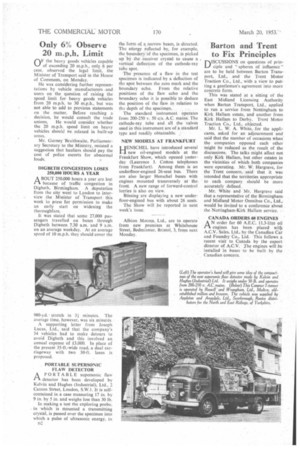Only 6% Observe 20 m.p.h. Limit
Page 48

If you've noticed an error in this article please click here to report it so we can fix it.
OF the heavy goods vehicles capable of exceeding 20 m.p.h., only 6 per cent, observed the legal limit, the Minister of Transport said in the House of Commons, on Monday.
He was considering further representations by vehicle manufacturers and users on the question of raising the speed limit for heavy goods vehicles from 20 m.p.h. to 30 m.p.h., but was not able to add to previous statements on the matter. Before reaching a decision, he would consult the trade unions. He would consider whether the 20 m.p.h. speed limit on heavy vehicles should ne relaxed in built-up areas.
Mr. Gurney 'Braithwaite, Parliamentary Secretary to the Ministry, resisted a suggestion that hauliers should pay the cost of police escorts for abnormal loads.
DIGBETH CONGESTION LOSES 250,000 HOURS A YEAR
ABOUT 250,000 hours a year are lost because of traffic congestion in Digbeth, Birmingham. A deputation from the city went to London to interview the Minister of Transport this• week to press for permission to make an early start on widening the thoroughfare.
It was stated that some 27,000 passengers travelled on buses through Digbeth between 7.30 a.m. and 9 a.m. on an average weekday. At an average speed of 10 m.p.h. they should cover the 980-yd.. stretch in 31 minutes. The average time, however, was six minutes.
A supporting letter from Joseph Lucas, Ltd., said that the company's 34 vehicles had to make detours to avoid Digbeth and this involved an annual expense of £3,000. In place of the present 35-ft.-wide road, a dual carriageway with two 30-ft. lanes is proposed.
PORTABLE SUPERSONIC FLAW DETECTOR
A PORTABLE supersonic flaw 11.. detector has been developed by Kelvin and Hughes (Industrial), Ltd., 2 Caxton Street, London, S.W.1. It is selfcontained in a case measuring 17 in. by 9 in. by 5 in. and weighs less than 30 lb.
In making a test the exploring probe, in which is mounted a transmitting crystal, is passed over the specimen into which a pulse of ultrasonic energy, in n2 the form of a narrow beam, is directed. The energy reflected by, for example, the boundary of the specimen, is picked up by the receiver crystal to cause a vertical deflection of the cathode-ray tube spot.
The presence of a flaw in the test specimen is indicated by a deflection of the spot between the zero mark and the boundary echo. From the relative positions of the flaw echo and the boundary echo it is possible to deduce the position of the flaw in relation to the depth of the specimen.
The standard instrument operates From 200-250 v. 50 cis. A.C. mains. The cathode-ray tube and all the valves used in this instrument are of a standard type and readily obtainable.
NEW MODELS AT FRANKFURT
HENSCHEL have introduced several new oil-engined models at the Frankfurt Show, which opened yesterday (Laurence J. Cotton telephones from Frankfurt). Among them is an underfloor-engined 26-seat bus. There are also larger Henschel buses with engines mounted transversely at the. front. A new range of forward-control lorries is also on view.
Bussing are displaying a new underfloor-engined bus with about 26 seats.
The Show will be reported in next week's issue.
Albion Motors, Ltd., are to operate from new premises at Whitehouse Street, Bedminster, Bristol, 3, from next Monday.










































































































